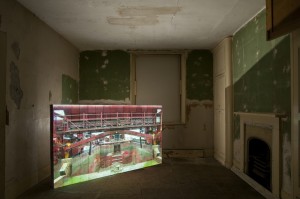
In the servant quarters of a Regency Townhouse in Brighton, you can now see a film about one of the harshest jobs on the South Coast. Namely, dredging and processing aggregate for cement.
And as if to stop the metropolitan art crowd from getting too cosy, civil engineer turned artist Loomes has projected her film onto a 16 x 9 wall of cubed concrete bricks.
This arrangement represents the aspect ratio (16:9) for most televisions and laptop screens. It’s a bit ironic that, because aggregate must be one of the least visible industries around.
Indeed, the raw material has lain hidden on the sea floor for some 150 million years. The fine sand and small stone, for which the building industry hungers, comes from Ice Age river beds.
This is the relict of the work’s title. Like the words relic and derelict, the term for raw aggregate comes from a Latin root. Relinquere means, of course, to leave behind.
But in the 15th century a relict was a widow. One might suppose that if you marry a shiftworker who works eight hours on/eight hours off for up to a fortnight at a time, you might feel that way.
So whether working on a hoover ship just outside the harbour or at the noisy plant which can process 600 tonnes of relict material per hour, you have what one worker calls a “good secure jobâ€.
Loomes captures the voices of the men who work here and the moments of mechanical violence and occasional peace which fill each working day. There’s almost a romance about this industry.
Relict Material is a co-commission by Photoworks and HOUSE Festival and can be seen at The Regency Townhouse, Brighton, until May 24 2015.
No Comments